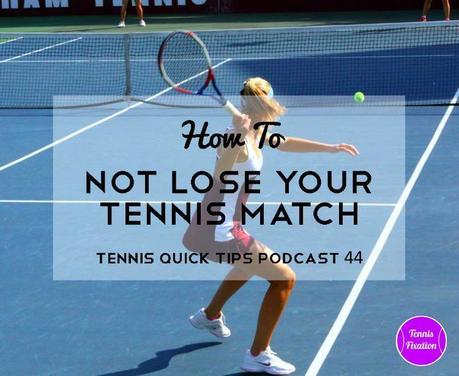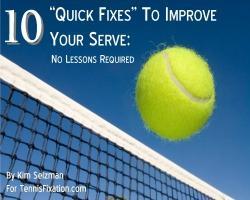Podcast: Play in new window | Download
What’s the difference between winning a tennis match and not losing a match? And how can you make sure you’re doing the right one of those things the next time you hit the courts? In this episode of Tennis Quick Tips, I’ll explain the difference between winning and not losing, talk about how the pros do it vs. how we regular tennis players do it, and give you my best tips for not losing your next tennis match. You can listen to this episode by clicking on the media player above, by downloading to your computer or device, or by listening in with your favorite podcast app. You can also subscribe in iTunes by clicking on this link: tennisfixation.com/itunes.

SHOW NOTES:
Have you ever heard this great tennis one-liner? Most tennis matches are not won, they’re lost. Huh? Is there ay deep tennis lesson there or is that just a useless saying that sounds like it’s saying something but is really just so much useless jibberish? Well, in my opinion, there’s definitely something there. And that’s why, in this podcast episode, we’re going to talk about how to not lose your next match.
I was thinking about this recently because I got an email from my good friend and avid tennis player Jonny raising an interesting point about the most recent French Open finals. Jonny said:
I just finished watching the Men’s and Women’s French Open Tennis Finals this weekend. I’m always struck at what a high level the championship matches are played and how few “unforced errors” there are. In thinking about this, I thought it would be telling to know the percentage of points won by a player where they actually “won” the point as opposed to winning a point as a result of an unforced error by their opponent. I think that this would be a good way to measure the quality of play in a match. I hear commentators talk about unforced errors, yet I’ve never heard them speak to this issue. In watching Nadal and Djokovic play, it just seems that many of their points won are as a result of a winning shot or forcing the other player to make a mistake. Have you ever thought about this?
Jonny makes an excellent point that not only have I considered, but I actually think about a lot in my own play. Jonny’s point is that it appears that, at the pro level, the players are winning the matches by hitting winners, not by making less unforced errors than their opponents. He’s wondering if that’s actually what’s happening. And what I’m wondering is, is that what’s happening in the matches at our level too, the level of the recreational non-pro player.
But let’s first look at the situation that Jonny’s comment raises – at the pro level, what’s going on? Did Rafael Nadal win the French Open by hitting more winners than Novak Djokovic or by making less errors? First, I can tell you, that analysis definitely exists. I’ll put a link to the match stats page from the official Roland Garros web site in the show notes to this episode which you can find at http://tennisfixation.com/quicktips44.
That page gives you a complete breakdown of the statistics from each of the four sets that Nadal and Djokovic played. Those statistics show that, for the entire match, Nadal hit 44 winners to Djokovic’s 43 winners. So they both hit almost the exact same number of winners. As far as unforced errors, Nadal only made 38 to Djokovic’s 49. And, at their level, I think Djokovic’s 11 additional unforced errors are significant.
There’s at least one other statistic that looks pretty interesting to me and that is that Djokovic hit 11 aces while Nadal only hit 3. If you look at those stats, plus a few others that are given on that web page, it seems clear that Nadal was playing a steady game of consistency while Djokovic was going for it, being a little more aggressive, and ultimately making more errors. And in the end, Nadal won, or you could say he did not lose, his record-setting 9th French Open final.
What does this mean for players like you and me? Well, what I think it means is that being the consistent player, rather than the one who hits the winners, is often the key to winning, i.e., not losing, tennis matches. Cutting back on your unforced errors and consistently getting the ball back, while letting your opponent go for the winners, is an actual plan that you can apply on court. It may not be as flashy, it may not seem like you’re doing much work at times, but it is a way to not lose more matches.
One of my favorite tennis books, one that I’ve read and re-read several times, is Tennis Beyond Big Shots by Greg Moran, and I’ll have a link to that book in the show notes for this episode. In his book, Moran says:
In today’s big shot world, the ability to “just” get the ball back has somehow become something to be looked down upon. . . . To develop into a winning tennis player, [however,] you must first and foremost become consistent with all of your shots. This means being able to keep the ball down the center of the court with as much ease as you unzip your racket bag. Consistency is the foundation on which the rest of your game will be built, and if you learn to keep the ball in play you’ll always be a tough opponent.
Moran’s advice to us recreational players? Play consistently first and foremost.
So how do you become more consistent during a match? How do you cut down on your unforced errors? How do you go from losing a match to not losing a match? Here are my tips to help you out:
First, you need to be aware of what’s happening on your court. You need to think about how the points in your match are being won and lost. In his book, Winning Ugly, another favorite tennis book that I’ll link to, Brad Gilbert tell us that,
The correct tennis response to any situation during your match can only be determined by knowing ‘who’s doing what to whom.’ A successful tennis player knows the answer. They may not know the exact numbers and percentages . . . but they have a sense of it. It’s an ability you can develop if you work at it.
So, during your next tennis match, take just a few seconds periodically, especially when you’re losing, to think about what is happening on court. Is your opponent hitting incredible winners that you just can’t deal with? Or are you giving them free points by making too many unforced errors? I’m betting that most of the time it’s the latter.
The way I do this is to stop and think, “Is my opponent hitting great winners that I can’t deal with or not?” As Brad Gilbert pointed out, I don’t need to know how many winners they’ve hit, I just need a sense of it. And if my sense it that they’re hitting winners, then I know I need to change my game plan and quit giving them shots that they obviously love and can deal with. If my sense is that my opponent ISN’T hitting incredible winners but I’m still losing, then I know I’m making too many unforced errors and I need to become more consistent with my shots and stop going for incredible winners myself.
Now, if you’ve thought about it and realize that you’re losing because of your unforced errors, my second tip is to become more consistent, at least until you can turn your losing position into a winning one. How do you become more consistent? Well, practicing a lot would be a good place to start. But, in the middle of a match, with the shots you currently possess, you can still become more consistent by playing it safer. This may mean taking something off your serve to cut back on missed first serves or double faults. It may mean hitting a safer, more consistent return to cut back on returns that fly out or get poached. It may mean playing a lob game for a little while, to give yourself more time during shots and to take away the fast-paced game your opponent is winning with. It may mean hitting short shots or low, slice shots to move your opponent around. Whatever it is you have to do, you need to implement a safer, more consistent game that will help reduce your errors.
You may have to use this safer, more consistent Plan B to finish out your match. Or you may only need to use it long enough to yourself back into the match at which point you can return to your Plan A. Either way, continue thinking during the match about what you’re doing on court and what your opponent is doing so you can decide how to deal with the situtation.
My third and final tip for not losing your tennis match, is specific to doubles and that is to communicate with your partner. This is probably the best tip for any doubles match but it is especially important in this situation as it may be your partner who is making the unforced errors and thereby not winning your match. Being confrontational about this is obviously never a good idea. Rather, if your team is making too many unforced errors, you need to point this out to your partner by telling them something like, “Hey, let’s play more conservatively for a bit and see if we can turn this around.” Or “Hey, we’re just handing them the points so let’s slow things down and make them do the work.” You may need to adopt a more defensive strategy and position on court to help support your partner and to help cut back on the unforced errors.
So those are my three tips for not losing your next tennis match. To review, they are:
- Be aware of what’s happening in your match by figuring out who is doing what to whom.
- If you’re losing the match because of your unforced errors, adopt a safer, more consistent game plan.
- In doubles, make sure you communicate with your partner about what is happening on court and be ready to play defensively to cut back on your unforced errors.
I want to thank Jonny for emailing me with his great comment and for being a Tennis Fixation follower. If you’d like to follow along with Tennis Fixation, get weekly tennis tips and updates, and get a copy of my free ebook – 10 Quick Fixes to Improve Your Serve – No Lessons Required, just visit TennisFixation.com and sign-up with your email address in the sidebar under the cover photo of the ebook.
All of the show notes for this episode, including links to the books I mentioned, can be found over at TennisFixation.com/QuickTips44.
And if you have questions about the game or if you have suggestions about what you’d like to hear on Tennis Quick Tips, you can email me at [email protected]. All of my contact info, show notes for this episode and for all of the other Tennis Quick Tips episodes can be found over at TennisFixation.com.
RESOURCES AND LINKS FROM THIS EPISODE:
Click for link to – Roland Garros 2014 – Match Statistics for Rafael Nadal vs. Novak Djokovic match
Tennis Beyond Big Shots by Greg Moran (this is an Amazon affiliate link)
Winning Ugly by Brad Gilbert (this is an Amazon affiliate link)
SHARE THIS EPISODE:
If you enjoyed this episode, or know someone who might, please feel free to share it with them. You can simply direct people to:
http://tennisfixation.com/quicktips44
There are also sharing and email buttons at the bottom of this post.
PLEASE SUBSCRIBE AND REVIEW:
If you’d like to get Tennis Quick Tips delivered easily to your device with each new episode, please subscribe using your preferred method below



If you’d like the direct RSS feed for your own favorite RSS Podcast Player, click here to get it!
And if you’d like to become a friend of the show, please leave an honest review on iTunes by clicking here. It will help the show become more easily discovered by like-minded, awesome people just like you. I appreciate it!
Thanks so much for listening and, as always, Happy Tennis!

© Kim Selzman 2014 All Rights Reserved



